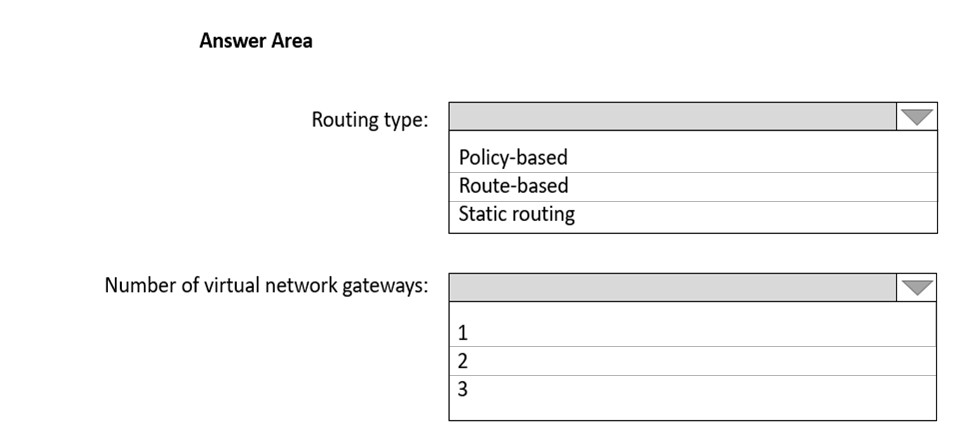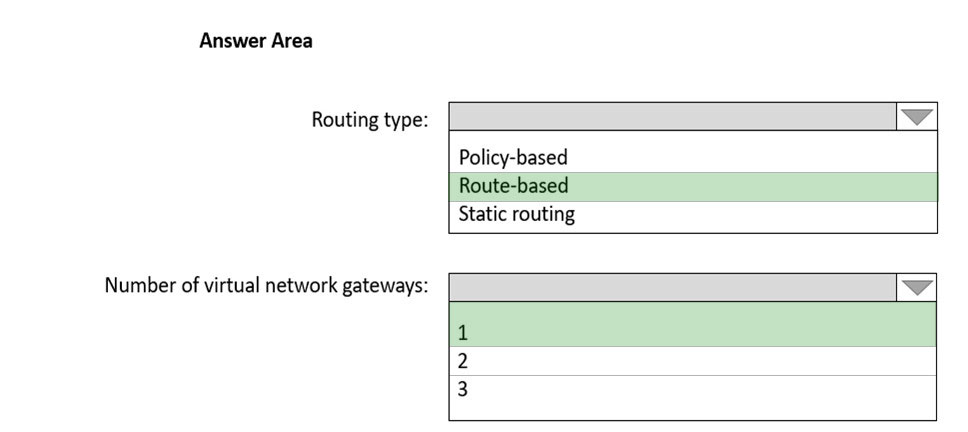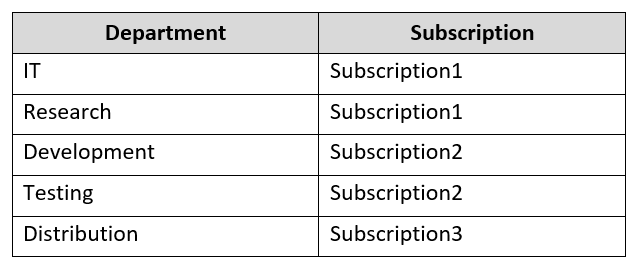You have an Azure virtual network and an on-premises datacenter.
You are planning a Site-to-Site VPN connection between the datacenter and the virtual network.
Which two resources should you include in your plan? Each correct answer presents part of the solution.
NOTE: Each correct selection is worth one point.
Answer:
BG
Reference:
https://docs.microsoft.com/en-us/azure/vpn-gateway/tutorial-site-to-site-portal
HOTSPOT -
You need to connect an on-premises network and an Azure environment. The solution must use ExpressRoute and support failing over to a Site-to-Site VPN connection if there is an ExpressRoute failure.
What should you configure? To answer, select the appropriate options in the answer area.
NOTE: Each correct selection is worth one point.
Hot Area:
Answer:

Reference:
https://docs.microsoft.com/en-us/azure/expressroute/expressroute-howto-coexist-resource-manager
Your company has an on-premises network and three Azure subscriptions named Subscription1, Subscription2, and Subscription3.
The departments at the company use the Azure subscriptions as shown in the following table.
All the resources in the subscriptions are in either the West US Azure region or the West US 2 Azure region.
You plan to connect all the subscriptions to the on-premises network by using ExpressRoute.
What is the minimum number of ExpressRoute circuits required?
Answer:
A
Reference:
https://docs.microsoft.com/en-us/azure/expressroute/expressroute-introduction
Your company has offices in New York and Amsterdam. The company has an Azure subscription. Both offices connect to Azure by using a Site-to-Site VPN connection.
The office in Amsterdam uses resources in the North Europe Azure region. The office in New York uses resources in the East US Azure region.
You need to implement ExpressRoute circuits to connect each office to the nearest Azure region. Once the ExpressRoute circuits are connected, the on-premises computers in the Amsterdam office must be able to connect to the on-premises servers in the New York office by using the ExpressRoute circuits.
Which ExpressRoute option should you use?
Answer:
B
Reference:
https://docs.microsoft.com/en-us/azure/expressroute/expressroute-global-reach
HOTSPOT -
You have an Azure subscription. The subscription contains virtual machines that host websites as shown in the following table.
You have the Azure Traffic Manager profiles shown in the following table.
You have the endpoints shown in the following table.
For each of the following statements, select Yes if the statement is true. Otherwise, select No.
NOTE: Each correct selection is worth one point.
Hot Area:
Answer:

Box 1: No -
VM1, which is hosting site1.contoso.com, is located in East US. The VM1 endpoint status is degraded. Endpoint monitoring health checks are failing. The endpoint isn't included in DNS responses and doesn't receive traffic.
When an endpoint has a Degraded status, it's no longer returned in response to DNS queries. Instead, an alternative endpoint is chosen and returned. The traffic- routing method configured in the profile determines how the alternative endpoint is chosen.
Priority. Endpoints form a prioritized list. The first available endpoint on the list is always returned. If an endpoint status is Degraded, then the next available endpoint is returned.
The user will connect to site2.us.contoso.com instead.
Box 2: No -
VM3, which is hosting site2.contoso.com, is located in in East US. The VM3 endpoint status is CheckingEndpoint. The endpoint is monitored, but the results of the first probe haven't been received yet. CheckingEndpoint is a temporary state that usually occurs immediately after adding or enabling an endpoint in the profile. An endpoint in this state is included in DNS responses and can receive traffic.
User will connect to site2.contoso.com, not to site2.uk.contoso.com
Box 3: No -
VM3, which is hosting site2.contoso.com, is located in in East US. The VM1 endpoint status is CheckingEndpoint, which is OK (see above).
User will connect to site2.contoso.com, not to site2.japan.contoso.com
Reference:
https://docs.microsoft.com/en-us/azure/traffic-manager/traffic-manager-monitoring
You have an Azure application gateway configured for a single website that is available at https://www.contoso.com.
The application gateway contains one backend pool and one rule. The backend pool contains two backend servers. Each backend server has an additional website that is available on port 8080.
You need to ensure that if port 8080 is unavailable on a backend server, all the traffic for https://www.contoso.com is redirected to the other backend server.
What should you do?
Answer:
A
By default, Azure Application Gateway probes backend servers to check their health status and to check whether they're ready to serve requests. Users can also create custom probes to mention the host name, the path to be probed, and the status codes to be accepted as Healthy. In each case, if the backend server doesn't respond successfully, Application Gateway marks the server as Unhealthy and stops forwarding requests to the server. After the server starts responding successfully, Application Gateway resumes forwarding the requests.
Note: The default probe request is sent in the format of <protocol>://127.0.0.1:<port>/. For example, http://127.0.0.1:80 for an http probe on port 80. Only HTTP status codes of 200 through 399 are considered healthy. The protocol and destination port are inherited from the HTTP settings. If you want Application Gateway to probe on a different protocol, host name, or path and to recognize a different status code as Healthy, configure a custom probe and associate it with the HTTP settings.
Reference:
https://docs.microsoft.com/en-us/azure/application-gateway/application-gateway-backend-health-troubleshooting
You have an Azure subscription that contains the following resources:
• A virtual network named Vnet1
• Two subnets named subnet1 and AzureFirewallSubnet
• A public Azure Firewall named FW1
• A route table named RT1 that is associated to Subnet1
• A rule routing of 0.0.0.0/0 to FW1 in RT1
After deploying 10 servers that run Windows Server to Subnet1, you discover that none of the virtual machines were activated.
You need to ensure that the virtual machines can be activated.
What should you do?
Answer:
B
You have an Azure subscription.
You plan to implement Azure Virtual WAN as shown in the following exhibit.
What is the minimum number of route tables that you should create?
Answer:
B
Note: This question is part of a series of questions that present the same scenario. Each question in the series contains a unique solution that might meet the stated goals. Some question sets might have more than one correct solution, while others might not have a correct solution.
After you answer a question in this section, you will NOT be able to return to it. As a result, these questions will not appear in the review screen.
You have an Azure subscription that contains the following resources:
✑ A virtual network named Vnet1
✑ A subnet named Subnet1 in Vnet1
✑ A virtual machine named VM1 that connects to Subnet1
✑ Three storage accounts named storage1, storage2, and storage3
You need to ensure that VM1 can access storage1. VM1 must be prevented from accessing any other storage accounts.
Solution: You configure the firewall on storage1 to only accept connections from Vnet1.
Does this meet the goal?
Answer:
B
Note: This question is part of a series of questions that present the same scenario. Each question in the series contains a unique solution that might meet the stated goals. Some question sets might have more than one correct solution, while others might not have a correct solution.
After you answer a question in this section, you will NOT be able to return to it. As a result, these questions will not appear in the review screen.
You have an Azure subscription that contains the following resources:
✑ A virtual network named Vnet1
✑ A subnet named Subnet1 in Vnet1
✑ A virtual machine named VM1 that connects to Subnet1
✑ Three storage accounts named storage1, storage2, and storage3
You need to ensure that VM1 can access storage1. VM1 must be prevented from accessing any other storage accounts.
Solution: You create a network security group (NSG) and associate the NSG to Subnet1.
Does this meet the goal?
Answer:
B